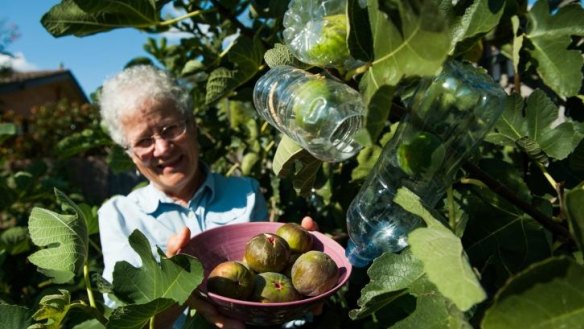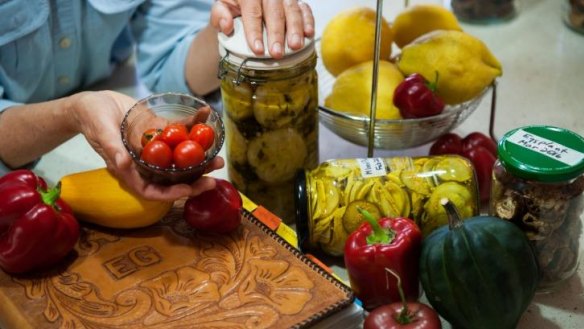Inside Esther Gallant's garden in Cook

In the garden of Professor Esther Gallant, a biologist at the John Curtin School of Medical Research, experiments are undertaken with a professional and creative impetus. When she moved into the house in Cook four years ago, one of the first purchases was a fig tree sold as a black genoa. It is not that variety and, last year, the figs appeared so late in the season that they never ripened properly. This season the crop is good but the tree is espaliered so it is difficult to net to keep possums and other predators and pests away so Gallant decided to grow each fig in a 350ml bottle. She bought 24-bottle slabs of water ($6 at major supermarkets) and attached 64 bottles to the tree, each one slit for easy access to the ripe fruit.
Esther Gallant grew up in New York state, where she gardened from the age of 5 and, as a teenager, had full responsibility for the quarter-acre farm vegetable garden, including growing seedlings. There has been a steep learning curve since moving to Canberra as gardening here is very different from the rural farm, which had abundant manure, and her time from 1997 at Iowa State University in Minnesota where there was metres of topsoil. Our milder weather with greens growing all winter are enjoyed as well as having "no weather to shovel".
At the garden in Cook there were 10-15cm of pebbles all over the garden except for the nature strip. So Gallant advertised "free landscape pebbles" at All Homes online site and people came to carry them away. New raised garden beds were in place for her first summer. They now cover about 30 square metres and she has nearly reached her goal of "zero food miles" for fruit and veg with the exception of mangoes, a new taste for her.

Home production is supplemented with feral apples from wild trees growing along the Monaro Highway, blackberries from pine forests where Gallant goes bushwalking, and plums from street trees around Cook. With permission from home owners she picks loquats to go on breakfast muesli or porridge or makes jam with them.
Three water tanks with 2500-litre capacity are covered with boysenberry vines, which produced 8kg of berries that have been frozen. Contents of Tumbleweed Mulch Maker and Tardis-style compost containers enrich the soil.
Highlights this autumn have been the handsome striped listada di gandia eggplants grown from seed and green patch table gem squash, called acorn squash in North America, which Gallant grew in Minnesota and found they were long keepers. Favourite tomatoes are the American cherokee which grew to 500g each in Canberra and the brandywine, which weighed in at 630g, though a possum destroyed five large tomatoes in two nights.
There are two feijoas and a trio of tromboncino zucchini dangle from one like a living sculpture. Newly available from Diggers is a purple heart fig, which produces purple fruit, and a lemon tree, which came with the house and produces two crops of 100 lemons in a year. Separate beds are dedicated to carrots and rhubarb. A four-tier mini-greenhouse is used to raise three varieties of broccoli, kale, perpetual spinach, Chinese mustard and vitamin greens with leaves that are good to eat but bugs think so too. Kentucky wonder and blue lake climbing beans hang down from a shade trellis.
On the kitchen window sill are petrie dishes from the lab in which dwarf and climbing snowpeas take two days to germinate. The freezers are full, there are jars of pickles and a Fowlers dehydrator is used for apples, red capsicums, eggplant and figs. Eggplants are preserved by peeling and slicing, salted for 24 hours then rinsed, steeped in cider vinegar for a further 24 hours and drained well, then packed into jars with chopped garlic, oregano and parsley and covered with olive oil.
Recipes are kept in a tooled leather notebook, which Gallant's mother made for her as a high school student and they include her mother's recipe for bread and butter pickles.
Bread and butter pickles
9 large cucumbers, zucchini and/or yellow crook-neck squash
½ cup salt
Mix salt with water to dissolve. Add sliced veg and enough water to cover. Mix well and weigh down with a plate. Leave in fridge overnight. Rinse well, about three times, and strain well.
Pickling solution:
5 cups cider vinegar
2 cups sugar
1 tsp turmeric
2 tbsp mustard seed
2 tsp celery seed
Boil for four minutes. Add sliced veg and bring just to a boil. Turn down heat and bottle immediately, pack sterilised jars with slices and fill to overflowing with solution. Wipe rim and cover tightly. Store in a dark place.
The best recipes from Australia's leading chefs straight to your inbox.
Sign up